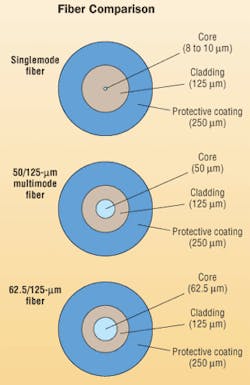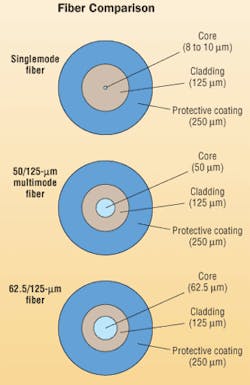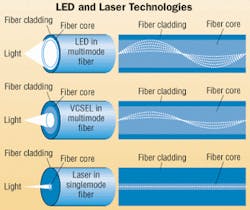Singlemode will go the distance
Singlemode optical-fiber cable and its active electronics will take you beyond the 10-Gigabit Ethernet barrier.
Multimode and singlemode optical-fiber cable can support a wide range of applications at fast speeds for long distances, but not all fiber is created equal.
When working with distances up to 2 km, use multimode optical-fiber cable. Singlemode optical-fiber cable, however, is more bandwidth-intensive and has less potential for modal dispersion and noise than multimode optical-fiber cable, translating to the ability to transmit beyond the distance limitations of multimode. (See table page 56.)
"One of the beauties about fiber is the smaller the core, the higher the bandwidth, but the lower the cost," says Steve Martin, director of product management, premises products, Superior Essex (www.superioressex.com). "Once the 1,310-nm vertical-cavity surface-emitting laser (VCSEL) technology is available, which I think will happen sometime within the next five years, the multimode market will go away."
How will we surpass 10-Gigabit Ethernet? The answer seems to be singlemode optical-fiber cable and the abilities of its end equipment. At the moment, the industry is divided over who will need 10-Gigabit Ethernet, and the necessary active components are not expected to be available until 2003 (see "Multimode or singlemode-which one is the best for 10-Gigabit Ethernet?" April 2002, page 35), but we can examine now how singlemode optical-fiber cable and proper end equipment could make this possible.
Designers and installers are increasingly recommending hybrid optical-fiber cable (see "Hybrid optical cable offers two benefits in one," November 1998, page 43) for the building backbone, in addition to the campus backbone. This is largely a result of the growing realization that singlemode optical-fiber cable will be needed to handle tomorrow's technologies.
Backbone options
There is no difference between the design of singlemode and multimode optical-fiber cables, but constructions for indoor and outdoor cable differ. You want to have an indoor cable for the building backbone and an outdoor cable for the campus backbone.
Most manufacturers use a loose-tube construction for singlemode optical-fiber cable designed for the campus backbone. This construction is widely used in external networks and for long-haul situations where the pulling stresses during installation are greater. It is less expensive than a tight-buffered construction. ITT Industries, Network Systems & Services (www.ittnss.com), uses a tight-buffered construction since it is designed for all circumstances within premises cabling situations. Namely, that it can be used for vertical riser situations that would otherwise necessitate the use of service loops every 10 meters.
A cable needs to be able to survive nature's elements if it is to be installed outdoors. ITT Industries' wet duct cable is an example of a singlemode optical-fiber cable designed for outdoor use. The wet duct cable has a water-swellable yarn between the inner sheath and outer sheath. In the event of a physical puncture of the outer sheath, the yarn will plug any ingress of water. The inner sheath will still offer protection. A gel in the tubes of a loose-tube construction can also react to extreme temperatures to provide protection from weather conditions.
Anthony Cicero, director of technology, Americas, ITT Industries, Network Systems & Services, tries to influence end users to use singlemode optical-fiber cable for the building backbone. "The main reason we encourage people to do this is for the simple reason that multimode fiber, especially OM3 fiber, will cover them for the next few waves of technology increases, such as 10-Gigabit Ethernet," says Cicero. "But when you start getting into 100-Gbit and terabit backbones, multimode fiber is not going to do it for you. You're going to need singlemode fiber." He bases this prediction upon how technologies tend to increase every five years. "Our market's predictions are based on Moore's Law , but we've actually exceeded it in realization," explains Cicero. "We expect that terabit backbones in campus environments will be a reality, probably by the year 2007."
Size doesn't matter?
Singlemode optical-fiber cable doesn't have a standard core size. Core size typically ranges between 8 and 10 µm, but it varies by manufacturer. "Singlemode behaves like singlemode as long as you retain the mode of light above the cutoff wavelength, which is where the mode of light becomes two modes. So, it [core size] doesn't have to be quite as precise as a multimode cable," says Jay Kochman, sales support engineer, fiber, Krone Inc. (www.krone.com). The core size measurement is not a critical measurement. Kochman says the measurement that you want to pay attention to is "mode field" diameter-the actual width of the light, and some of the light resides outside the core during singlemode transmission. This measurement usually ranges from 9 to 12 µm.
"If you were to mix singlemode fibers with different core sizes from different manufacturers on your transceiver equipment, the difference would be so minute that the amount of light loss would be insignificant," says Cicero.
The physical core doesn't retain all of the light. As a result, some of the light travels along the fiber cladding. "This causes dispersion of the light, meaning that some of the light will arrive at the receiver at different times," continues Kochman. "Light that travels outside the core travels a little faster than the light that travels inside the core."
Singlemode optical-fiber cable is extremely bend-sensitive, and any minor kink could disturb the signal. In an effort to erase the dispersion, some manufacturers are making singlemode optical-fiber cable with non-zero dispersion-shifted fiber. A glass manufacturer can adjust the core cladding profile to slow down some of the light traveling outside of the core, so that all of the light reaches the receiver at the same time. Problem solved? Make sure you read the fine print. Non-zero dispersion-shifted fiber can sometimes only be effective at certain wavelengths or for specific applications. "A cable could have non-zero dispersion-shifted fiber, but might reduce the effects of dispersion only at a specific wavelength or link length," warns Kochman.
Reliable source
First, you need to choose the right fiber wavelength for the application. "In Ethernet-type systems, you choose between 1,310- and 1,550-nm wavelengths," says Rob Gilberti, director of marketing, Draka-Chromatic Technologies Inc. (www.drakausa.com). From there, you choose your electronics. Gilberti says it all comes down to how fast you want to go and how far you want to go.
Source technology is a large part of the reason why singlemode optical-fiber cable has an insignificant amount of modal dispersion or noise. "To drive optical signals through singlemode optical-fiber cable, you need laser transceivers, which are, in some cases, 10 times the cost of an LED or a low-end transceiver like a VCSEL transceiver," says Cicero. Multimode optical-fiber cable uses LEDs or low-end VCSELs.
In a recently published white paper offered by NORDX/CDT (www.nordx.com) 10-Gbit/sec LAN Net working: Optical Fiber LAN Design Considerations, Richard Perron, engineer, RCDD-LAN specialist, NORDX/CDT, explains the difference. He says LEDs disperse light in a pattern wider than the core diameter of the fiber, which overfills the fiber core. For laser technology, the light is designed to disperse only in the middle of the fiber core due to the precision of the launch. A VCSEL is designed to launch light in a pattern that is contained within the core of the fiber. When the light is not as dispersed, less modal dispersion is created and the amount of information that can travel on the fiber tends to be increased, depending on the fiber's properties.
Anthony Cicero says the high-end 1,550-nm infrared laser transceivers operate in different "window modes" than VCSELs. Infrared lasers let you multiplex your signals like in a broadband environment. This gives you flexibility, but it doesn't come without a heavy monetary cost. On the other hand, a VCSEL may be all that you need in the immediate future. "If you are running Gigabit or 10-Gigabit Ethernet in a backbone or campus environment where between buildings you are not exceeding a couple miles, you don't really need to use the high-end lasers," says Cicero. "The faster you go and the farther you go, the more sophisticated active equipment you are going to need."
To break the 10-Gigabit barrier, you will need to use the high-end lasers with singlemode optical-fiber cable. "If you were to use a type of highly amplified light other than a laser, you won't see that crisp, straight beam [you would see with a laser] because light is made up of different wavelengths," explains Steve Martin. "Lasers are able to have a strong, straight beam because it is made up of one wavelength."
Today's high-end lasers are distributed feedback (DFB) lasers. "The advantages of these lasers are that they are available now and have a higher potential output," says Martin. What's holding back the availability of lasers for use with singlemode? "A 1,310-nm VCSEL has been manufactured in a laboratory environment, but the amount of power that goes into it is too high for the substraight," continues Martin. "Heat dissipation is a big issue."
Weighing the costs
At the moment, multimode is less expensive to install than singlemode, but this is the result of the costs of end equipment. The glass used for singlemode optical-fiber cable is actually less expensive than the grade of glass used for multimode. Kochman says that with singlemode, everything is "tighter." "Connectors [for singlemode] have to be ceramic and they're drilled to a tighter tolerance. Mating adapters have a tighter tolerance," says Kochman. "Contractors spend more on labor, including polishing and splicing as a result."
Rob Gilberti says that for the cost of singlemode optical-fiber cable to come down, components need to be more readily available. "The more sources and receivers that are available, the more the cost will go down. Right now, there are only a handful of vendors that are manufacturing these products."
"If multimode and singlemode cost the same, there would be very few reasons to pick multimode over singlemode," says Gilberti. "If it all cost the same, you would put in singlemode fiber because your capacity would be so much higher that you would never need to put in another cable." At the moment, if you do not need this capacity now, it is hard to justify a strictly singlemode system. But in a couple years, you might.
Ryan Cliche is assistant editor of Cabling Installation & Maintenance.


